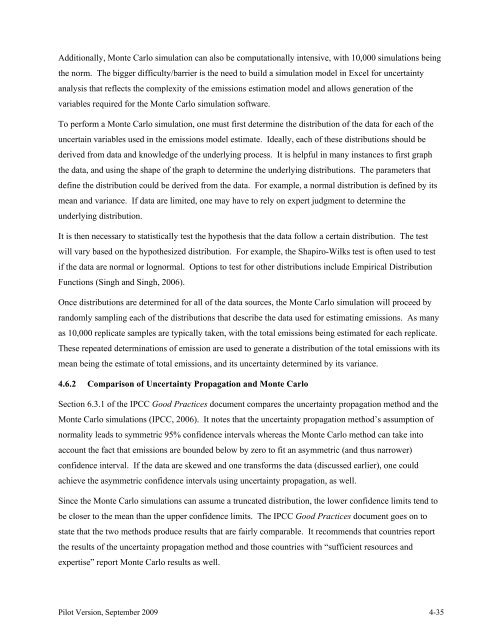addressing uncertainty in oil and natural gas industry greenhouse
addressing uncertainty in oil and natural gas industry greenhouse
addressing uncertainty in oil and natural gas industry greenhouse
You also want an ePaper? Increase the reach of your titles
YUMPU automatically turns print PDFs into web optimized ePapers that Google loves.
Additionally, Monte Carlo simulation can also be computationally <strong>in</strong>tensive, with 10,000 simulations be<strong>in</strong>g<br />
the norm. The bigger difficulty/barrier is the need to build a simulation model <strong>in</strong> Excel for <strong>uncerta<strong>in</strong>ty</strong><br />
analysis that reflects the complexity of the emissions estimation model <strong>and</strong> allows generation of the<br />
variables required for the Monte Carlo simulation software.<br />
To perform a Monte Carlo simulation, one must first determ<strong>in</strong>e the distribution of the data for each of the<br />
uncerta<strong>in</strong> variables used <strong>in</strong> the emissions model estimate. Ideally, each of these distributions should be<br />
derived from data <strong>and</strong> knowledge of the underly<strong>in</strong>g process. It is helpful <strong>in</strong> many <strong>in</strong>stances to first graph<br />
the data, <strong>and</strong> us<strong>in</strong>g the shape of the graph to determ<strong>in</strong>e the underly<strong>in</strong>g distributions. The parameters that<br />
def<strong>in</strong>e the distribution could be derived from the data. For example, a normal distribution is def<strong>in</strong>ed by its<br />
mean <strong>and</strong> variance. If data are limited, one may have to rely on expert judgment to determ<strong>in</strong>e the<br />
underly<strong>in</strong>g distribution.<br />
It is then necessary to statistically test the hypothesis that the data follow a certa<strong>in</strong> distribution. The test<br />
will vary based on the hypothesized distribution. For example, the Shapiro-Wilks test is often used to test<br />
if the data are normal or lognormal. Options to test for other distributions <strong>in</strong>clude Empirical Distribution<br />
Functions (S<strong>in</strong>gh <strong>and</strong> S<strong>in</strong>gh, 2006).<br />
Once distributions are determ<strong>in</strong>ed for all of the data sources, the Monte Carlo simulation will proceed by<br />
r<strong>and</strong>omly sampl<strong>in</strong>g each of the distributions that describe the data used for estimat<strong>in</strong>g emissions. As many<br />
as 10,000 replicate samples are typically taken, with the total emissions be<strong>in</strong>g estimated for each replicate.<br />
These repeated determ<strong>in</strong>ations of emission are used to generate a distribution of the total emissions with its<br />
mean be<strong>in</strong>g the estimate of total emissions, <strong>and</strong> its <strong>uncerta<strong>in</strong>ty</strong> determ<strong>in</strong>ed by its variance.<br />
4.6.2 Comparison of Uncerta<strong>in</strong>ty Propagation <strong>and</strong> Monte Carlo<br />
Section 6.3.1 of the IPCC Good Practices document compares the <strong>uncerta<strong>in</strong>ty</strong> propagation method <strong>and</strong> the<br />
Monte Carlo simulations (IPCC, 2006). It notes that the <strong>uncerta<strong>in</strong>ty</strong> propagation method’s assumption of<br />
normality leads to symmetric 95% confidence <strong>in</strong>tervals whereas the Monte Carlo method can take <strong>in</strong>to<br />
account the fact that emissions are bounded below by zero to fit an asymmetric (<strong>and</strong> thus narrower)<br />
confidence <strong>in</strong>terval. If the data are skewed <strong>and</strong> one transforms the data (discussed earlier), one could<br />
achieve the asymmetric confidence <strong>in</strong>tervals us<strong>in</strong>g <strong>uncerta<strong>in</strong>ty</strong> propagation, as well.<br />
S<strong>in</strong>ce the Monte Carlo simulations can assume a truncated distribution, the lower confidence limits tend to<br />
be closer to the mean than the upper confidence limits. The IPCC Good Practices document goes on to<br />
state that the two methods produce results that are fairly comparable. It recommends that countries report<br />
the results of the <strong>uncerta<strong>in</strong>ty</strong> propagation method <strong>and</strong> those countries with “sufficient resources <strong>and</strong><br />
expertise” report Monte Carlo results as well.<br />
Pilot Version, September 2009 4-35

















